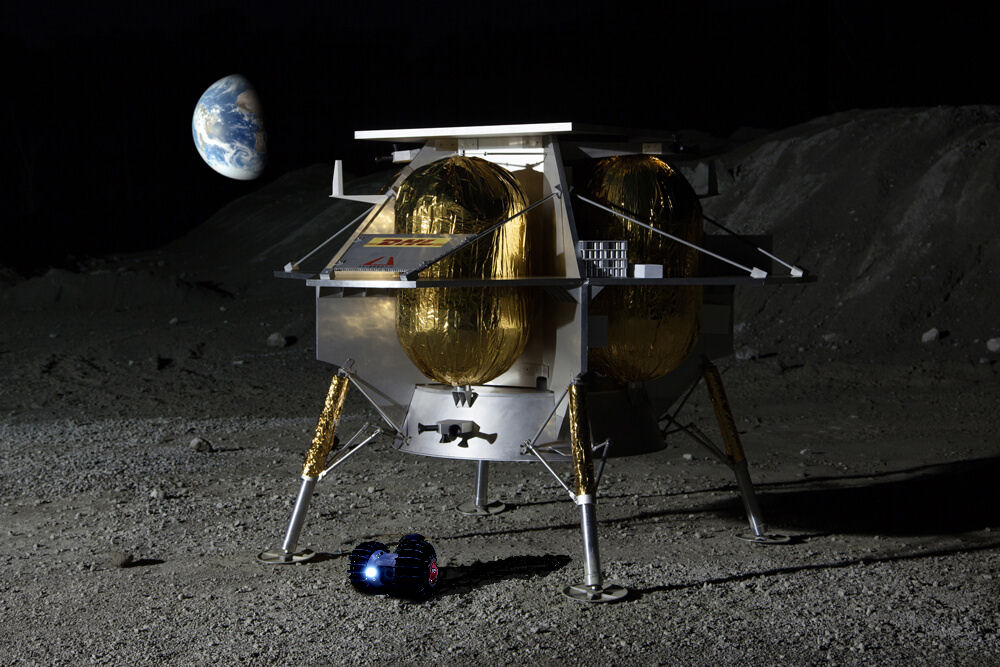
The firsts keep rolling in for a 2021 moon mission.
The Pittsburgh-based company Astrobotic plans to send its robotic Peregrine lander to the lunar surface in July 2021, on a mission sponsored by NASA's Commercial Lunar Payload Services (CLPS) program. The flight will be the first for Peregrine and its rocket, United Launch Alliance's new Vulcan Centaur vehicle, and may mark the first successful moon landing by a private spacecraft. (Another commercial lander and CLPS awardee, Intuitive Machines' Nova-C, is scheduled to launch around the same time.)
Peregrine will also carry the United Kingdom's first-ever moon rover, a little, four-legged craft built by London-based company Spacebit. And another little pioneer will be on the flight as well, it turns out: Japan's first lunar rover, a tiny, wheeled robot named Yaoki, which was developed by Tokyo-based company Dymon.
Related: Moon Rush: These Companies Have Big Plans for Lunar Exploration
"We are really excited to fly our mission with Astrobotic. This lunar rover Yaoki will result in the first lunar rover from Japan to explore the lunar surface, and marks a unique contribution to Peregrine's mission," Dymon CEO Shinichiro Nakajima said in a statement.
"Yaoki has already successfully passed more than 100 tests and has the smallest but most effective rover wheels ever produced," Nakajima added. "We are ready to complete development and fly in 2021."
This first mission could be the start of something big on the moon for Dymon. The company aims to land 100 Yaokis by 2030, Dymon representatives have said.
Get the Space.com Newsletter
Breaking space news, the latest updates on rocket launches, skywatching events and more!
"Dymon’s unique, single-axle rover is a creative design that we look forward to delivering on Peregrine in 2021," Astrobotic CEO John Thornton said in the same statement. "We're excited to deliver this groundbreaking Japanese rover to the moon."
Yaoki and the "walking rover" from Spacebit will have a lot of company on the 2021 flight. Peregrine is toting to the lunar surface about 30 payloads, 14 of which will be provided by NASA.
The U.S. space agency is funding the mission, via CLPS, to the tune of $79.5 million. Intuitive Machines is getting $77 million for its first mission. (The company Orbit Beyond got $97 million in this round of CLPS awards, which were announced in May. But Orbit Beyond has since dropped out, saying it could not meet its September 2020 launch target.)
NASA views the CLPS-funded missions as key enablers of its Artemis program of crewed lunar exploration. That project aims to put astronauts down near the lunar south pole by 2024 and establish a permanent, sustainable human presence on and around the moon by 2028. For example, some of the science gear flying on the robotic landers will assess stores of lunar water ice, an important resource for potential explorers and settlers.
To date, just three entities have successfully soft-landed a spacecraft on the moon: the Soviet Union, the United States and China. The private Israeli outfit SpaceIL and the government of India tried to follow suit this year with the Beresheet and Chandrayaan-2 missions, respectively, but both came up short.
Dymon isn't the only Japanese company that wants to explore the moon. Tokyo-based ispace plans to put down a lander toting customer payloads in 2021, following that up with a rover-deploying surface mission in 2023.
- NASA's Full Plate of Moon Missions Before Astronauts Can Go
- Living on the Moon: What It Would Be Like (Infographic)
- Moon Master: An Easy Quiz for Lunatics
Mike Wall's book about the search for alien life, "Out There" (Grand Central Publishing, 2018; illustrated by Karl Tate), is out now. Follow him on Twitter @michaeldwall. Follow us on Twitter @Spacedotcom or Facebook.
Join our Space Forums to keep talking space on the latest missions, night sky and more! And if you have a news tip, correction or comment, let us know at: community@space.com.

Michael Wall is a Senior Space Writer with Space.com and joined the team in 2010. He primarily covers exoplanets, spaceflight and military space, but has been known to dabble in the space art beat. His book about the search for alien life, "Out There," was published on Nov. 13, 2018. Before becoming a science writer, Michael worked as a herpetologist and wildlife biologist. He has a Ph.D. in evolutionary biology from the University of Sydney, Australia, a bachelor's degree from the University of Arizona, and a graduate certificate in science writing from the University of California, Santa Cruz. To find out what his latest project is, you can follow Michael on Twitter.









